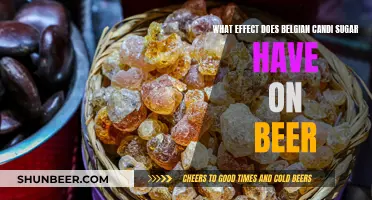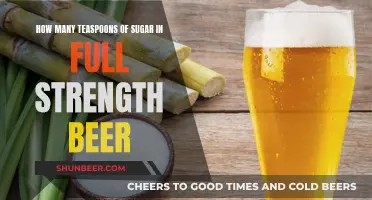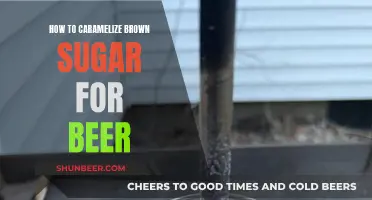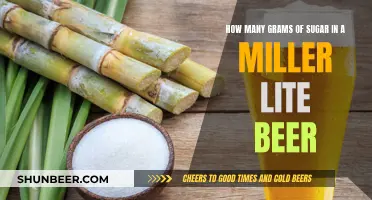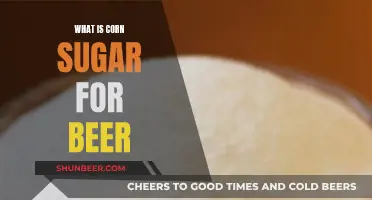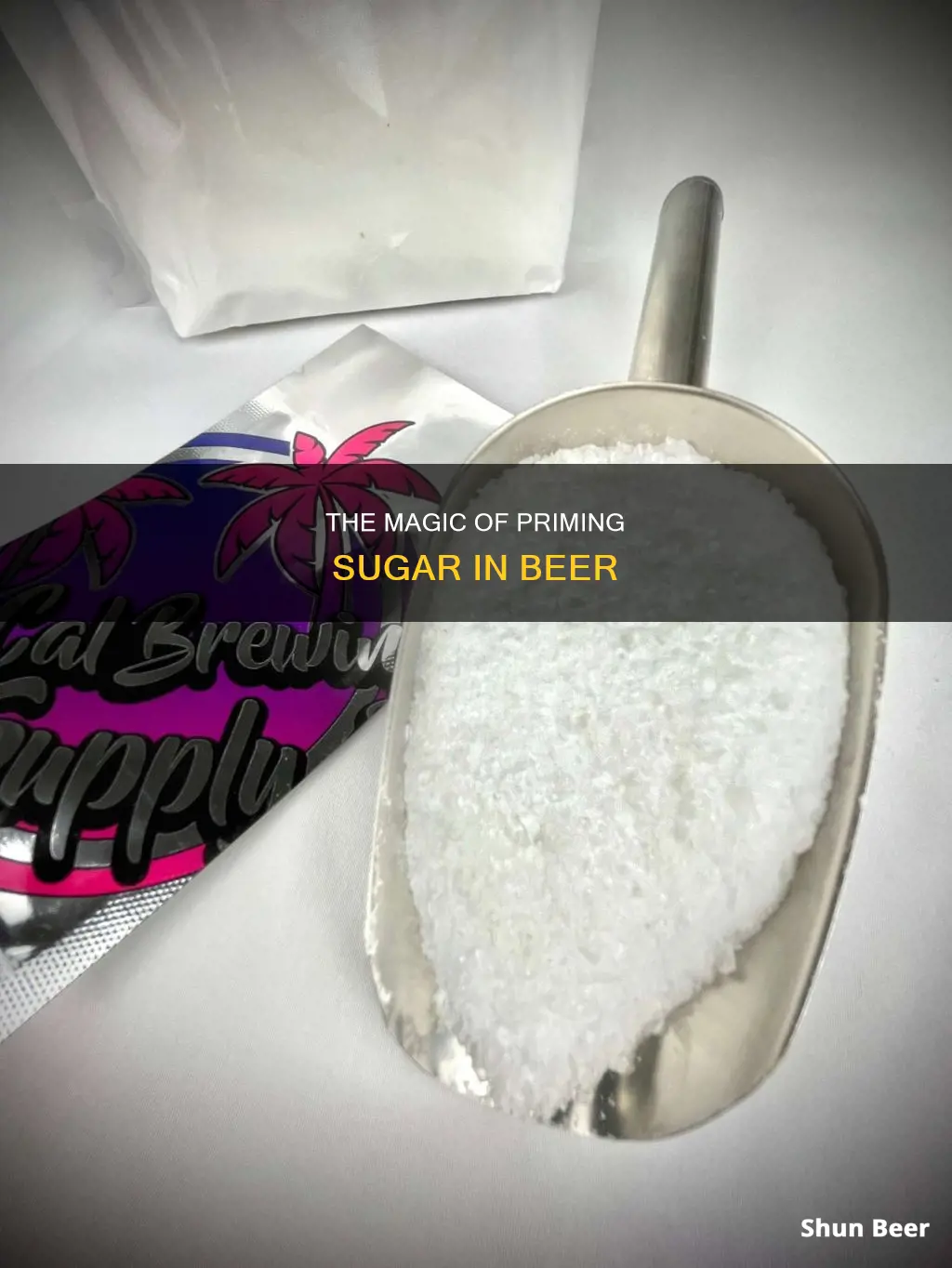
Carbonation is what gives beer its bubbles, fizz, and froth, and priming sugar is an essential part of the process of carbonating beer. After the first two stages of the fermentation process, beer has a small amount of carbonation, but it can achieve stronger carbonation through bottle conditioning, a final fermentation in the bottle. This is where priming sugar comes in. It is any kind of sugar that restarts the fermentation process and brings about the bubbles in the beer.
| Characteristics | Values |
|---|---|
| Purpose | Carbonating beer and giving it more fizz |
| Additional Qualities | Taste and aroma |
| Yeast | Provides a final source of sugar for yeast to feed on |
| Carbonation | Yeast converts sugar into CO2 inside sealed bottles to create carbonation |
| Types | Corn sugar, table sugar, dry malt extract, honey, molasses, carbonation tablets |
| Amount | 3/4 cup of corn sugar, 2/3 cup of table sugar, or 1 1/4 cups DME for a 5-gallon batch |
| Over-priming Risk | Bottles may overflow or explode |
| Under-priming Risk | Beer may be undercarbonated or flat |
What You'll Learn

Priming sugar is used to carbonate beer
Types of Priming Sugar
The most popular types of priming sugar are corn sugar (dextrose), table sugar (sucrose), and dry malt extract (DME). Corn sugar is the most popular option as it is affordable, widely available, and does not alter the flavour of the beer. Table sugar is also a common choice, although some people believe it makes the beer taste "cidery". Dry malt extract is less common as it can be unpredictable and take longer to ferment.
Calculating the Amount of Priming Sugar
Calculating the exact amount of priming sugar required depends on various factors, including the type and volume of the beverage, the desired carbonation level, and the temperature at which the beer was fermented. It is crucial to be precise with measurements to avoid under-carbonation or over-carbonation. Under-carbonation will result in flat beer, while over-carbonation can lead to overflowing bottles or even explosions.
Priming Sugar Alternatives
While priming sugar is a popular method for carbonating beer, there are alternatives such as carbonation tablets or drops. These tablets are added directly to the bottles and provide a convenient and precise way to carbonate beer without the need for calculations. However, they may not allow for fine-tuning the carbonation level.
Starch and Sugar in Beer: What's the Truth?
You may want to see also

It gives beer a fizzier texture
Priming sugar is added to beer to give it a fizzier texture. The sugar is added to the beer before bottling, and the yeast in the beer eats it and produces CO2, which has nowhere to go in the sealed bottle so it dissolves into the beer, creating a fizzier texture.
The process
The process of adding priming sugar to beer is called priming. It is usually done at home and is quite easy to carry out. After fermentation is complete, the beer is bottled. Then, the priming sugar is combined with water and heated to create a priming solution. This solution is then added to the bottled beer, and the yeast creates carbonation in the beer, making it fizzier.
Types of priming sugar
There are various types of priming sugar that can be used, including corn sugar, table sugar, and dry malt extract. Corn sugar is the most popular choice as it is affordable, widely available, and does not alter the flavour of the beer. Table sugar is also a common option, but some people believe it makes the beer taste "cidery". Dry malt extract is less common as it can be unpredictable and take longer to ferment.
Benefits of priming sugar
Priming sugar is a cheap and simple way to carbonate beer and improve its texture and taste. It is also a safe option as it does not require the purchase of CO2, which can be dangerous if not handled properly.
Calculating the amount of priming sugar
It is important to calculate the correct amount of priming sugar to use, as too much can lead to over-carbonation and cause bottles to overflow or explode, while too little can result in under-carbonated or flat beer. Online calculators and priming sugar calculators can help determine the right amount of priming sugar needed for the desired level of carbonation.
Beer and Sugar: What's the Connection?
You may want to see also

It can be used to improve the taste and aroma of beer
Adding priming sugar to beer can improve its taste and aroma. It is a common practice among homebrewers to prime beer using priming sugar solutions. This can give the beer a lot of extra fizz and possibly even create a better taste and aroma.
The type of priming sugar used can make a difference. Simple sugars such as normal white table sugar or sucrose can be used as priming sugar, but it won't add any flavour or aroma to your beer. On the other hand, using more "natural" sugars such as dark brown sugar or honey will get you the fizz, along with an amplified taste and a nicer aroma.
The amount of priming sugar used can also affect the taste of the beer. For example, using too much priming sugar can result in over-carbonation, potentially causing excessive foaming or even causing bottles to explode. Using too little priming sugar could result in under-carbonated beer, which might lack the expected level of fizziness.
Priming sugar is added to beer during bottling to carbonate it. The yeast in the beer consumes the sugar and produces CO2, which has nowhere to go in the bottle so it dissolves into the beer, creating the carbonation that gives the beer its fizz.
Stag Beer's Sweet Secret: Sugar Content Revealed
You may want to see also

It can be dangerous to use priming sugar incorrectly
Priming sugar is an essential part of the beer-making process, but it can be dangerous to use it incorrectly.
Priming sugar is added to beer before bottling to create carbonation and influence the flavour, sweetness and colour. It's important to use the correct amount of priming sugar for your brew, as using too much can result in over-carbonation, causing excessive foaming or even exploding bottles. On the other hand, using too little priming sugar can lead to under-carbonated beer, which may lack the desired level of fizziness. Therefore, it is crucial to calculate the precise amount of priming sugar needed to achieve the desired carbonation level.
To ensure consistent carbonation across all bottles, it is recommended to dissolve the priming sugar in boiling water before adding it to the brew. This helps distribute the sugar evenly throughout the mixture. Additionally, it is important to use the correct type of sugar for priming, as different sugars can have varying effects on the beer's flavour and aroma. For example, corn sugar and cane sugar generally do not contribute any additional flavour, while dry malt extract (DME) can influence the taste due to its grain base.
Furthermore, the timing of adding priming sugar is crucial. It is typically added after the first stage of fermentation, known as the residual carbonation level, to achieve the desired target carbonation level. Adding priming sugar at the wrong time or in the incorrect amounts can lead to inconsistent carbonation levels and potential bottle explosions.
In conclusion, while priming sugar is essential for creating carbonation and enhancing the flavour of beer, incorrect usage can lead to dangerous situations. It is important to calculate the precise amount of priming sugar needed, use the correct type of sugar, and add it at the right time during the brewing process to avoid potential hazards and create a well-balanced, delicious beer.
Yeast and Sugar: Beer's Sweet Science Explored
You may want to see also

Common priming sugars include corn sugar, table sugar, and dry malt extract
Corn sugar, table sugar, and dry malt extract are the most popular forms of priming sugar. Corn sugar is a good option for first-time brewers as it is easy for yeast to consume and has a neutral flavour. It is also 100% fermentable, easy to handle, and has a low moisture content. Table sugar, or cane sugar, is a less expensive option that also won't add any flavour to the beer. It is also 100% sweet stuff. Dry malt extract (DME) can influence the taste of the beer as it is made from grains. It can also cause a Kräusen ring to form in the necks of bottles, though this is harmless.
The amount of each of these priming sugars required per 5 gallons of beer is as follows:
- 3/4 cups (4 ounces, or 113 grams) of corn sugar
- 2/3 cup (5.3 ounces, or 150 grams) of table sugar
- 1 1/4 cups (181 grams) of light dry malt extract
Stout Beer Sugar Content: What You Need to Know
You may want to see also
Frequently asked questions
Priming sugar is any sugar added to a fermented beer before bottling to carbonate it.
The yeast in the beer consumes the priming sugar and produces CO2, which has nowhere to go in a sealed bottle so it dissolves into the beer, creating fizz and carbonation.
The most popular types of priming sugar are corn sugar (dextrose), table sugar (sucrose), and dry malt extract (DME). Corn sugar is the easiest for yeast to consume and has a neutral flavour.
The amount of priming sugar needed depends on the type and volume of the beverage. As a rule of thumb, for a 5-gallon batch, use 3/4 cup of corn sugar, 2/3 cup of table sugar, or 1 1/4 cups DME.
Using too much priming sugar can result in over-carbonation, causing bottles to overflow or even explode. Using too little priming sugar will result in under-carbonated or flat beer.


